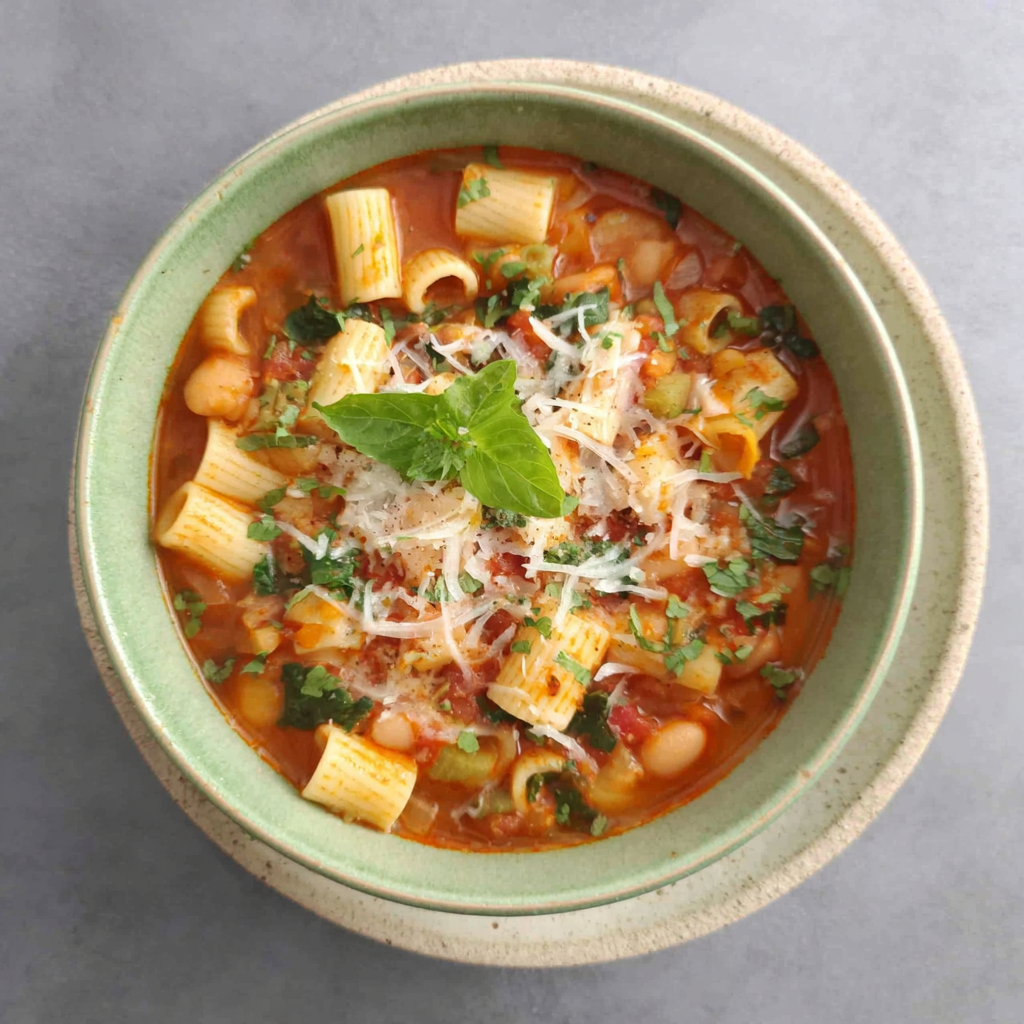Introduction
Pasta Fagioli, a beloved dish from Italy, embodies the warmth of comfort food with its rich flavors and rustic charm. This hearty soup is a celebration of simple ingredients that come together to create a satisfying meal, perfect for any season.
Typically made with pasta, beans, and a medley of vegetables, Pasta Fagioli is more than just a soup; it's a snapshot of Italian culinary tradition. It's often referred to as 'pasta and beans' in English, highlighting its two core components that meld harmoniously into a nourishing bowl.
Ingredients
- 1 cup ditalini pasta
The small, tubular shape of ditalini pasta is perfect for holding the flavors of the broth and ingredients, providing a delightful bite in every spoonful. - 1 can (15 oz) cannellini beans, drained and rinsed
Cannellini beans offer a creamy texture and a subtle nutty flavor that enriches the soup. They also add protein, making the dish more filling. - 1 medium onion, diced
Onion provides a sweet base flavor that deepens as it cooks. Its aromatic qualities enhance the overall taste of the soup. - 2 cloves garlic, minced
Garlic adds a fragrant punch that elevates the dish with its distinctive warmth and depth, melding beautifully with the broth. - 2 carrots, diced
Carrots contribute natural sweetness and a touch of earthiness, creating a balanced flavor profile while adding vibrant color to the soup. - 2 celery stalks, diced
Celery offers a refreshing crunch and an aromatic quality, enhancing the soup's texture while balancing the other flavors. - 1 can (14 oz) diced tomatoes
Diced tomatoes introduce acidity and brightness that counteracts the creaminess of the beans, while their juices create a rich broth. - 4 cups vegetable or chicken broth
Broth serves as the soup's flavorful base, infusing the dish with depth and warmth. Choose low-sodium options for better control over saltiness. - 2 tablespoons olive oil
Olive oil is essential for sautéing the vegetables, imparting richness and a fruity note that enhances the overall flavor of the dish. - 1 teaspoon dried oregano
Dried oregano provides earthy, Mediterranean notes that are quintessential in Italian cooking, bolstering the dish’s flavor profile seamlessly. - Salt and pepper to taste
Seasoning at each stage of cooking is crucial to build layers of flavor in the soup, allowing the individual ingredients to shine through. - Fresh parsley, chopped (for garnish)
Garnishing with fresh parsley not only adds a pop of color but also a fresh, herbal note that brightens the richness of the soup.
Directions & Preparation
Step 1: Heat olive oil in a large pot over medium heat.
Starting with a warm pot helps to release the flavors of the aromatics. Olive oil is chosen for its flavor and health benefits, creating the perfect foundation for your soup.
Step 2: Sauté the diced onion, carrots, and celery until soft.
This 'mirepoix' combination forms the aromatic base of your soup. Softening these vegetables releases their natural sugars, adding sweetness and depth to the flavor.
Step 3: Add garlic and sauté for an additional 1-2 minutes.
Garlic cooks quickly, releasing its aroma and flavor. Adding it after the mirepoix ensures it doesn’t burn, which would make it bitter, preserving its delicate taste.
Step 4: Stir in the diced tomatoes, dried oregano, salt, and pepper.
Integrating the tomatoes and spices at this stage allows them to marry with the sautéed vegetables, enhancing the dish’s overall flavor profile as they simmer together.
Step 5: Pour in the broth and bring the mixture to a boil.
Bringing the broth to a boil ensures the flavors meld and the ingredients cook uniformly. This initial heat jump starts the cooking process for the pasta.
Step 6: Add the ditalini pasta and beans, and reduce heat.
Adding the pasta and beans transforms the broth into a hearty soup. As they cook, the pasta absorbs the flavors, while the beans add creaminess and protein.
Step 7: Simmer for about 10-12 minutes until pasta is al dente.
Monitoring the cooking time is vital; overcooked pasta becomes mushy. Al dente ensures a satisfying texture that holds up well in the soup.
Step 8: Adjust seasoning before serving.
Tasting and adjusting seasoning at the end allows you to personalize the soup’s flavors. This step is essential to achieving a balanced final dish that highlights all the components.
Step 9: Garnish with fresh parsley before serving.
Garnishing adds visual appeal and a fresh note that elevates the richness of the soup. Serve hot for an inviting meal that warms the soul.

Variations to Elevate Your Pasta Fagioli
Pasta Fagioli is a flexible dish that lends itself well to variations, including the addition of leafy greens like spinach or kale for extra nutrients. You could also swap out ditalini for another pasta shape, such as rotini, which offers a different texture but retains the soup's heartiness. For a protein boost, consider adding diced ham or Italian sausage, which melds beautifully with the other ingredients.
Perfect Pairings with Pasta Fagioli
To complement the robust flavors of Pasta Fagioli, serve it alongside crusty Italian bread, perfect for soaking up the delicious broth. A simple arugula salad dressed with lemon and olive oil provides a refreshing contrast to the richness of the soup. Pairing it with a glass of Chianti or a crisp white wine can elevate the dining experience, enhancing the flavors of this classic dish.
The Roots of Pasta Fagioli
Pasta Fagioli, or 'pasta and beans', stems from humble origins, historically viewed as peasant food in Italy. Its creation is rooted in necessity, where frugality dictated hearty meals using affordable ingredients. Each region of Italy adds its own twist and local ingredients, showcasing the adaptability of the dish, which has evolved while retaining its comforting essence over generations.
FAQs
Can I use different types of beans?
Yes, you can use different beans such as kidney beans or black beans, depending on your taste preference. Just ensure they are cooked or canned for convenience.
What should I do if the soup is too thick?
If the soup is too thick, add more broth or water gradually until you reach your desired consistency. Stir well and adjust seasoning accordingly.
Can I add meat to this recipe?
Certainly! Diced ham, cooked Italian sausage, or even shredded chicken can enhance the heartiness of the soup. Just add these proteins after sautéing the vegetables.
How can I make the soup vegetarian?
Using vegetable broth instead of chicken broth and omitting any meat additions will easily make this soup vegetarian. It's just as delicious!
What type of pasta can I use if I can't find ditalini?
If ditalini isn't available, you can substitute with small pasta like elbow macaroni or fusilli, keeping in mind that cooking times may vary.
What if my Pasta Fagioli turns out bland?
If your soup is lacking flavor, try adding more herbs, adjusting the seasoning with salt and pepper, or incorporating a splash of balsamic vinegar for depth.
Should I cook the pasta separately before adding?
It's not necessary to cook the pasta separately; adding it directly to the soup allows it to absorb the broth’s flavors as it cooks.
Can I serve this dish cold?
While traditionally served hot, you can allow it to cool and serve it chilled as a unique twist. Just be sure to store it properly if making ahead.
Conclusion
Pasta Fagioli is more than just a dish; it's a comforting hug in a bowl, perfect for gatherings or cozy family dinners. Its adaptability allows you to make it uniquely yours while enjoying the essence of traditional Italian cuisine.
So gather your ingredients, immerse yourself in the cooking process, and savor every bite of this flavorful Italian classic, beautifully blending simplicity and heartiness.
Recipe Card
Notes
Additional serving suggestions: pair with a crisp salad, garlic bread, or roasted seasonal vegetables for balance.
For make-ahead, prep components separately and assemble just before heating to preserve texture.
Taste and adjust with acid (lemon/vinegar) and salt right at the end to wake up flavors.







